8+ Sample Criminal Investigation Report
-
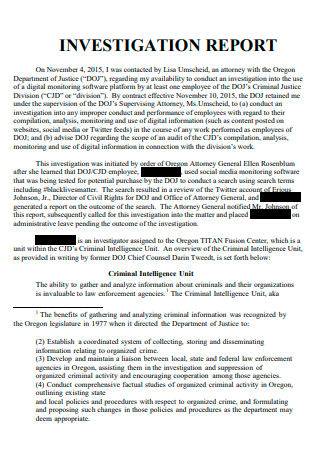
Criminal Investigation Report Template
download now -
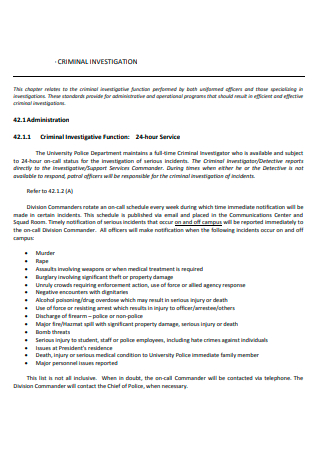
Basic Criminal Investigation Report
download now -

Criminal Investigation Committee Report
download now -

Criminal Investigation Summary Report
download now -
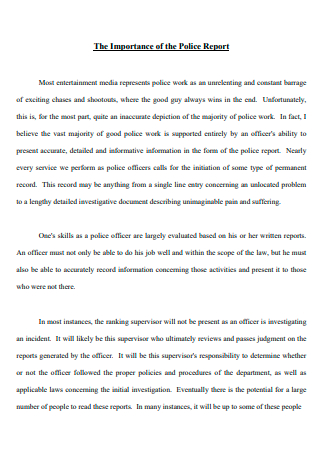
Criminal Investigation Police Report
download now -
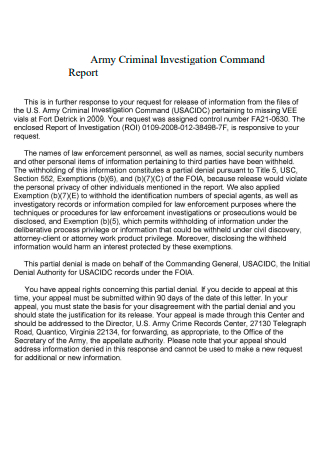
Army Criminal Investigation Command Report
download now -
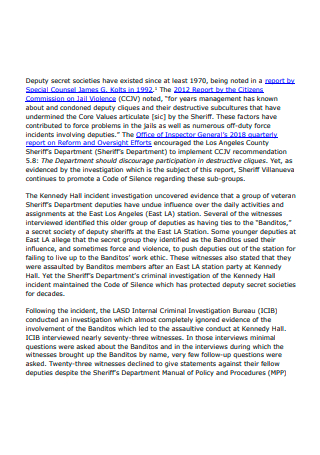
Printable Criminal Investigation Report
download now -

Criminal Investigation Report Example
download now -
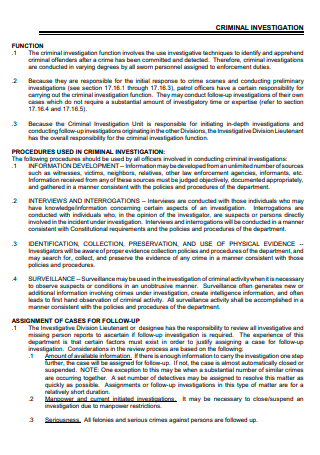
Standard Criminal Investigation Report
download now
FREE Criminal Investigation Report s to Download
8+ Sample Criminal Investigation Report
What Is a Criminal Investigation Report?
Characteristics of a Criminal Investigation Report
How to Create a Criminal Investigation Report
FAQs
What is the purpose of the criminal investigation report?
What is a criminal investigation?
What are the types of cases being investigated in a criminal investigation?
What are the characteristics you need in order to become a good criminal investigator?
What are some of the quick tips when writing a criminal investigation report?
What Is a Criminal Investigation Report?
In the world of crime and law enforcement, a criminal investigation report, also known as a police report, is a documentation created by law enforcement officers or police detectives that contains facts, information, and/or evidence pertaining to a case or a crime to: find out if a crime has been committed; find out who are the perpetrators; arrest the perpetrators; and to provide the evidence that can be upheld in the court of law. The investigation report is important since it is being used by decision-makers in determining the next course of action in a criminal case. The report goes through timely and accurate investigation or fact-gathering.
One of the problems law enforcement officers encounter when making a criminal investigation report is the relevance and the validity of information that they have gathered. Although there is often an abundance of information available, the dilemma often is checking if the information available is relevant to the case at hand, if it is accurate or not, or sometimes if the information given is complete or not.
According to an article in FindLaw, “The primary tools that police have when investigating crimes are interviews or interrogations and collecting physical evidence. They then use the information that they have collected to piece together a possible scenario as to what happened that the collected evidence will support.”
The most common types of criminal investigations are: fraud; homicide; cyber crimes or cyber security; crimes against property; sexual assault; narcotics; gang violence; and forensic investigation. When collecting information for the investigation report, it should be specific and relevant to the type of case at hand. The criminal investigation report should be concise and specific and on point towards the smart goal of the investigation.
Characteristics of a Criminal Investigation Report
A criminal investigation report deals with a wide and diverse spectrum of research and problem solving. It is multi-faceted, and requires a great deal of critical thinking and attention to detail by the investigating officer. Upon arriving at the scene of the crime, the investigating officer goes through a standard motion on securing the crime scene and collecting the data needed for the report.
Trained in the thinking process of gathering information, the investigation officer starts going about collecting relevant information, beginning with asking the basic questions of who, what, why, where, when, and how. All of those details are entered into the criminal investigation report. The goal of a criminal investigation report is to assist the law enforcement authorities in the decision-making process of how to solve and/or conclude a crime.
Obviously, a distorted and unclear report is of no help at all. The qualities of a criminal investigation report have a major impact in the resolution of a criminal case. But what makes up a criminal investigation report? What are its characteristics that differentiate it from the other kinds of report?
How to Create a Criminal Investigation Report
A criminal investigation report is a methodological documentation of the event that led to the perpetuation of the crime. Its aim is to educate and persuade the reader based on facts that led up to the crime. It is a document that is being used as a basis for law enforcement officers in solving a crime and/or to build up a case against the perpetrators under the court of law.
Nobody really likes writing a report. The thought of going through the painstaking process of finding and pulling up all the details needed in a report is something that, well, no one really looks forward to doing. In this case, since a criminal investigation report is a very important piece of documentation plan, the one making the report has to go through that whole laborious process, being very meticulous, thorough, and diligent when making the report. After all, the output of the investigation report greatly impacts the whole criminal case itself.
Fortunately, we can make the process “painless” for the investigator. Here on our website, we have various investigation templates to choose from. You can personalize it to fit the type of report you are making, and it is very much easy to follow through. If you want to know more how to create a criminal investigation report from scratch, these are the standard steps followed when making the report:
Step 1: Write Down Your Objective for the Report
Inform the reader what you are investigating and what do you hope to achieve out of it. For example: “The investigation is designed to determine the cause of death of (John Doe), whose body is located around (building/location) in New York City. We intend to prevent similar incidents from happening by addressing the root cause of the case at hand.”
Step 2: Background
This will be the Incident Report. Be objective when writing down the incident. Do not go straight and give the underlying cause or details that are not appropriate. Write down what happened. This is the part where you answer the questions who, what, where, when, why, and how. Now, you may not be able to answer all of the questions as of the moment, but that’s where investigation later on takes place next. In the incident report, you write down the type of incident (theft, property damage, death, et cetera); the address, time, date of the incident; name (if applicable) of the victim; and/or incident statement or description. An example could be: Vehicle Incident Report Statement – Vehicle ran off the road. Potential injury.
Step 3: Investigation
Start by writing down who are part of the investigation team, their positions and qualifications. The investigation should start gathering physical evidence needed in the case such as video footage, documents, interviews, physical objects, et cetera. Next, provide the details you gathered during the investigation. Include the full names and contact information of all the people you’ve talked to relevant to the incident. They could be witnesses, victims, or the suspects. Afterwards, write down the details of any site visits you made. You could also provide photographs, sketches, et cetera.
If you made some interrogations, or gathered some witness statements, there is no need to provide the whole transcript of the conversation. It is not necessary to attach all of the documents, just as long as you can get hold of these records any time when needed. A summary is sufficient, that includes details and results of the investigation or any simulations, tests, or reconstructions of the incident that you did during the course of the investigation.
Step 4: Findings and Recommendation
Write down your findings in a logical and a concise manner. Avoid confusion as much as possible. Remain objective. State the recommendation report based on the supporting facts and evidence. Make sure that your recommendation ties up with your findings. Your recommendation should answer the question of what happens next. An example could be: Driver of the vehicle recommended to be detained.
FAQs
What is the purpose of the criminal investigation report?
The criminal investigation report aims to educate and persuade the reader- those involved in the investigation process, including the decision-makers- in the process how to solve and/or conclude a crime investigation.
What is a criminal investigation?
It is a thorough, multi-faceted investigation involving logical facts and evidence surrounding a crime scene. These are then used to locate and identify the guilt or innocence of an individual or a group of individuals.
What are the types of cases being investigated in a criminal investigation?
The common types of criminal cases being investigated are: fraud; homicide; cyber crimes or crimes on cyber security; crimes against property; sexual assault; narcotics; gang violence; and forensic investigation.
What are the characteristics you need in order to become a good criminal investigator?
For someone to become a good criminal investigator, that person needs to be: a) passionate in finding the truth, b) observant and logical, c) objective when stating facts and findings, d) patient and committed, e) analytical and critical thinker, and f) knowledgeable and skilled with the proceedings.
What are some of the quick tips when writing a criminal investigation report?
Answer the questions who, what, where, when, why, and how. Always include accurate name and contact information of witnesses, victims, and suspects. Also, be accurate when including other details such as the correct address, license plate numbers, et cetera. State the outcome of the investigation you made, including the fingerprints, bloodstains, point of entry/exit, et cetera. Keep sentences short, brief, clear, and concise. Be direct to the point. Be objective throughout the process. Do not use slang, insensitive, and vulgar words. Check your grammar and spelling.
“Nothing matters but the facts,” said Blake Edwards. The criminal investigation process is all about facts. How it is presented is crucial in a criminal investigation report. Whatever is detailed in a criminal investigation report greatly impacts the outcome of the criminal case and also affects the future of the individuals involved in the case. The key to a good criminal investigation report is to be as factual and as objective as possible. Having a good logical flow of the incident is equally important as well. A good solid investigation report template can be your ally in this case. Check out our website and download one of our report templates. Find out how simple it is to create your own criminal investigation report!
